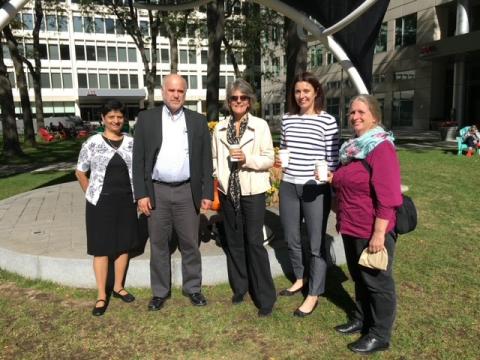After 35 Years, NIH’er Retires with Gratitude

I plan to retire end of 2021 and while it is something that I dearly look forward to, it is a bittersweet feeling. It is difficult to leave the NIH family behind, mine for close to 35 years. I joined in June 1987 as a CRADA fellow with a pharmaceutical company. However, the legalities took forever to be ironed out and I went through a period of not being paid. The senior leadership at NCI decided to step in and give me a visiting associate position.
It has been wonderful working in this organization. NCI has allowed me to grow both professionally as well as personally. I have worked with wonderful mentors—too many to mention by name. I started as a 32-year-old scientist with a 3-year-old son, after a 6-year postdoc stint at the University of Wisconsin. Within 2 years, our family grew with a baby girl. Both my husband, Sathya, and I worked on the main campus. That allowed us to meet sometimes for lunch in the cafeteria or go for walks in the afternoon. While those were busy days, they were lovely days as well. We enjoyed taking courses at the Foundation for Advanced Education in the Sciences as well.
I started working with Dr. Andrew Muchmore, a clinician-scientist in the Metabolism Branch in Bldg. 10 and enjoyed my foray into immunology. I was a pure biochemist up to that point. Attending immunology courses offered by FAES helped me immensely and allowed me to get up to speed in the field.
After 4 years on the main campus, I was offered a position as a senior staff fellow at the Laboratory of Nutritional & Molecular Regulation at Frederick and moved on to become a tenure-track investigator.
It was an exciting time: I was nervous about the competitive nature of being a tenure-track principal investigator and not sure what my chance was of getting tenured. Realizing my limitations being a mother of two young children, however, I decided to do the best I possibly could.
With my husband and I both being involved in laboratory research, life was hectic. Saturdays were working days for us. Tissue cultures had to be taken care of and thankfully, my children got accustomed to accompanying me to the lab. They thought most kids spent weekends with their moms in the lab.
Despite being an immigrant and a woman, I am happy to acknowledge that I have lived in a relatively safe “bubble” as a scientist. Discrimination did happen, but it was negligible. By and large, I found encouraging and supportive mentors.

Colleagues became good friends. When you spend long hours in the lab and share experiences in which your “beautiful hypothesis gets slayed by ugly facts” time and again, you learn to commiserate with your coworkers. You depend on each other to remain motivated…We learned the best way to comfort ourselves after a “failed experiment” was to get Italian ice at Rita’s!
Sometime in the 1990s, NCI-Frederick initiated the Werner K. Kirsten fellowship for rising Frederick High School seniors to entice them into careers in the biological sciences. They would get paid summer internships and then, during the school year, commit to spending a few hours a week in the lab. I enthusiastically signed up to be a mentor and over the course of 4 years, trained 4 bright young people. I enjoyed teaching them and was naïve enough to think that I was “inspiring” them with my research.
It turned out that these motivated, high-achieving individuals who worked with me over the course of a year would decide that this was not for them. Their reasons? The long hours I spent in the lab, my inability to spend weekends with my kids and being paid what they referred to as “not enough money!”
Dr. Vande Woude, one of my mentors in Frederick, introduced me to the NCI Extramural Program. I went on a detail for about 15 hours a week at the Center for Scientific Review and learned about grants review, study sections and program administration. It was a remarkable experience and changed the course of my scientific career. It enabled me to find a position as a program director in the Division of Cancer Biology, where I have worked since November of 1999. It has been a wonderful experience!
Rather than working on my own research, I have been a facilitator of science. While it was initially difficult for me to accept not having my own area of research, I came to appreciate the vicarious pleasure of mentoring fellow scientists getting their first grant and helping them navigate the challenges of being a researcher in cancer biology.
I retire with a certain amount of satisfaction, having made a difference in several scientists’ lives and am grateful for all I have learned.
